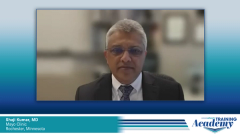
Bispecifics in MM: mSMART Guidelines for Monitoring and Managing AEs
Focused discussion on the mSMART guidelines for monitoring and managing adverse events associated with bispecific therapies in patients being treated for relapsed/refractory multiple myeloma.
Episodes in this series

Transcript:
Rafael Fonseca, MD: Shaji, we included in mSMART [Mayo Stratification for Myeloma and Risk-Adapted Therapy] public guidelines of recommendations for the community practice. They’re consensus driven, so they represent an opinion you’d get from Mayo Clinic doctors. But I wonder if you could comment on what we have for CRS [cytokine release syndrome] and ICANS [immune effector cell-associated neurotoxicity syndrome].
Shaji Kumar, MD: This is clearly something that’s going to be in the community and used extensively, hopefully in the next few years. It’s important that we have consistent guidelines in terms of managing cytokine release syndrome and ICANS. The good thing is that even though the frequency of CRS is high with bispecifics, it tends to be grade 1 for most patients with a few grade 2. What we’ve done as part of the mSMART guidelines—which span the entire spectrum of plasma cell disorders—is allow you to go onto the website at www.msmart.org and get guidelines for management of all plasma cell disorders you might see in the clinic.
We added to that collection how we’d manage somebody with cytokine release syndrome. The management is based on the underlying grade of CRS and ICANS. For patients who have grade 1, they can be managed with conservative measures—fluids, antipyretics, and so forth. But once you have grades 2 to 4, that needs specific therapy, and tocilizumab is what we’d use for those patients. For grade 1, we suggest you use 1 dose of dexamethasone. If there’s no improvement, then go on to tocilizumab. For grades 2 to 4, we’d definitely start with tocilizumab. It can be given up to 3 doses, with each dose given every 8 hours in addition to dexamethasone every 6 hours. This would be for patients with grades 2 to 4 CRS. Higher-dose steroids might be employed in patients who get persistent low- or high-grade CRS.
Other medications have been employed for management of CRS, and there’s a pretty exhaustive list of potential medications. Their dose and schedule can be found within the mSMART guidelines, so I’ll refer you there. In terms of the ICANS, this is based on the ASTCT [American Society for Transplantation and Cellular Therapy] 2019 guidelines. That’s what we use for grading. It uses the ICE [immune effector cell-associated encephalopathy] scoring system and the presence of other symptoms, including seizures. Generally, for ICANS, tocilizumab alone doesn’t work, and we depend on steroids. But if a patient has ICANS along with CRS, we’d use both tocilizumab and higher-dose steroids with much more careful monitoring. In particular, monitoring for seizures and so forth should be considered in patients with more severe ICANS. Certainly, these patients can have increased endocrine pressure. This needs to be kept in mind as we monitor these patients. With these guidelines we’ve tried to consolidate what’s out there in a convenient single location that you can go to as a point-of-care tool.
Rafael Fonseca, MD: Thank you. Dr Cook, there are other toxicities: hemotoxicity, neurotoxicity. I’d like to talk a little about infections in particular, especially as we think about duration of treatment, earlier use, and so forth. Tell us a little about your thoughts on other toxicities apart from CRS and ICANS.
Joselle Cook, MBBS: We have quite a bit of experience with BCMA bispecifics apart from teclistamab because of the BCMA clinical trials that are available at Mayo Clinic. We’ve developed experience and seen what has happened. One thing is infections, for sure. These infections can be high grade. In the teclistamab trial, for example, the rate of CRS infections was about 30%. This is something we need to be vigilant about. For my patients on BCMA bispecifics, I keep them on acyclovir prophylaxis and may even consider Bactrim [sulfamethoxazole-trimethoprim] prophylaxis. So, acyclovir and Bactrim prophylaxis for my patients. Intravenous immunoglobulin for patients with hypogammaglobulinemia is 1 other thing I’d recommend for patients on bispecifics.
You’re going to be seeing these patients routinely, so it’s important to be vigilant by asking about and monitoring for signs of infection. There are guidelines within the teclistamab product insert for how to hold the teclistamab dose. For all grades of infection, you hold in the step-up dosing period. Then there are recommendations and guidelines for holding for higher-grade infections.
Another thing to watch out for by monitoring is neutropenia, which occurred in about 84% of patients with teclistamab. I also see it with patients on other BCMA bispecifics on trials. Once the ANC [absolute neutrophil count] drops below 500 cells per mm3, I put my patients on Levaquin [levofloxacin] and fluconazole. There’s wiggle room to give doses of growth factor, if necessary, but I don’t necessarily jump to that right away. I allow some time or adjust the dosing of teclistamab, but that’s something we can implement for patients who develop neutropenia and prolonged neutropenia. Those are important things that occur commonly that we need to mention and advise our colleagues and community on to help look out for and assist them with management.
Dr Kumar covered neurotoxicity, so I don’t need to belabor that point. But other common things to look out for include headache, confusion, dysgraphia, or handwriting abnormality. Those are the most common things that occur with neurotoxicity in the early part of therapy with bispecifics. Dr Kumar already spoke about CRS, so I won’t belabor that point either.
Morie Gertz, MD: Things are going to get better. We’re still in this very early phase. We’re victims of our own system because we continue to look for the maximum tolerated dose [MTD], not the minimal effective dose. If you go back far enough, then you’ll know we never got the dose right for dexamethasone, thalidomide, bortezomib, belantamab, and pomalidomide—at 4 mg, it’s unnecessary. This issue of infection is a big deal, but maybe it doesn’t have to be every week or every 3 weeks depending on the preparation. Maybe [it should be] more time limited, not treatment related. We’ll figure it out, but it’s going to take time. It wouldn’t surprise me if we do more with less. That’s speculative and in the future. We’ve got MTDs and these infections, but maybe we’ll be a little flexible with our dosing schedule once we have more experience.
Rafael Fonseca, MD: I couldn’t agree more. We should be able to get better. Let’s continue the administration. We’ve seen T-cell–associated infections because you’re calling all the T cells to war all the time. We’re seeing things like CMV [cytomegalovirus] reactivation, PML [progressive multifocal leukoencephalopathy], and PJP [Pneumocystis jirovecii pneumonia]—things we don’t normally see with the usual therapies. The more effective multiple myeloma therapies are always a double-edged sword. You have humoral immunodeficiency. But with interventions, including IVIg [intravenous immunoglobulin], growth factors, preventive medicines, and schedule changes, we should be able to get much better. Shaji, anything else to add on infections that you think our audience should know?
Shaji Kumar, MD: No, it’s been well covered. The key thing we need to learn is, how much do the infections correlate with the duration of therapy? Other biomarkers we can monitor to tailor the therapy for individual patients with infection, whether it’s CD4 counts or other functional assays, to look at the immune system.
Morie Gertz, MD: I agree. Monitoring T-cell count is important. That’s routine in the CAR [chimeric antigen receptor] T space. Having some sense of CD4 recovery to figure out what prophylaxis is appropriate is important.
Rafael Fonseca, MD: Morie, can you give specific numbers for our community physicians who may be listening? If I’m going to measure CD4, what do I look for?
Morie Gertz, MD: It’s not very easy. My immunoglobulin replacement threshold is about 500 cells per mm3. That’s arbitrary and not very data driven. A CD4 count of 500 cells per mm3 is normal. If you’re above 150 cells per mm3, you’re going to do well. That’s based on looking at what happens in HIV. In HIV, CD4 goes below 50 cells per mm3—that’s a big threshold, below 50 cells per mm3. But the safe value is 150 cells per mm3. That’s made of whole cloth. If someone said, “It should be 250 cells per mm3, half of normal” or “It should be normal,” this would be difficult to argue with. Obviously, if I’m giving them acyclovir and sulfamethoxazole-trimethoprim, I’m going to err on the side of caution because I find those pretty benign agents. It’s the same thing with long-term fluconazole use against fungal infection. I’d rather err on the side of caution. We all know once you get a PJP infection it’s an absolute catastrophe. So, longer rather than shorter.
Transcript edited for clarity.
Newsletter
Stay up to date on recent advances in the multidisciplinary approach to cancer.























































































